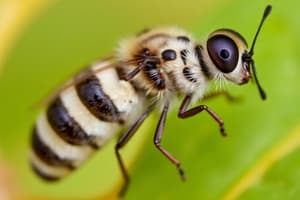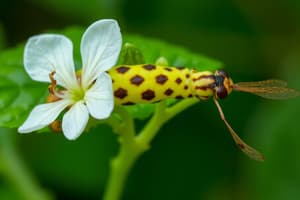Podcast
Questions and Answers
What does the Biological Species Concept primarily emphasize?
What does the Biological Species Concept primarily emphasize?
- Reproductive isolation (correct)
- Evolutionary lineages
- Physical traits of organisms
- Ecological roles
Which species concept is based on measurable physical traits?
Which species concept is based on measurable physical traits?
- Biological Species Concept
- Morphological Species Concept (correct)
- Ecological Species Concept
- Phylogenetic Species Concept
Why might multiple species concepts be necessary for identifying species?
Why might multiple species concepts be necessary for identifying species?
- Some species have no known ecological roles.
- It may be difficult to distinguish species with one concept alone. (correct)
- Each species has unique genetic information.
- Species can belong to multiple kingdoms.
What is a critical advantage of binomial nomenclature?
What is a critical advantage of binomial nomenclature?
How does the Ecological Species Concept define a species?
How does the Ecological Species Concept define a species?
What are the two parts of the binomial nomenclature?
What are the two parts of the binomial nomenclature?
Which of the following is true regarding the naming convention in binomial nomenclature?
Which of the following is true regarding the naming convention in binomial nomenclature?
Which statement best describes the biological species concept?
Which statement best describes the biological species concept?
What type of reproductive isolation occurs before fertilization?
What type of reproductive isolation occurs before fertilization?
What is a defining feature of reproductive isolation between species?
What is a defining feature of reproductive isolation between species?
Who developed the binomial nomenclature system?
Who developed the binomial nomenclature system?
Which of the following categories is not part of the hierarchical classification?
Which of the following categories is not part of the hierarchical classification?
What challenge can arise during species identification?
What challenge can arise during species identification?
Flashcards
Biological Species Concept
Biological Species Concept
A species concept that focuses on reproductive isolation between groups of organisms, meaning they cannot interbreed and produce fertile offspring.
Morphological Species Concept
Morphological Species Concept
A species concept that defines species based on measurable physical features, or morphology.
Phylogenetic Species Concept
Phylogenetic Species Concept
A species concept that defines species based on their evolutionary history and genetic relatedness.
Ecological Species Concept
Ecological Species Concept
Signup and view all the flashcards
Binomial Nomenclature
Binomial Nomenclature
Signup and view all the flashcards
What is binomial nomenclature?
What is binomial nomenclature?
Signup and view all the flashcards
What is a genus?
What is a genus?
Signup and view all the flashcards
What is a specific epithet?
What is a specific epithet?
Signup and view all the flashcards
What is a species?
What is a species?
Signup and view all the flashcards
What are reproductive isolation mechanisms?
What are reproductive isolation mechanisms?
Signup and view all the flashcards
What are prezygotic barriers?
What are prezygotic barriers?
Signup and view all the flashcards
What are postzygotic barriers?
What are postzygotic barriers?
Signup and view all the flashcards
What is biological classification?
What is biological classification?
Signup and view all the flashcards
Study Notes
Binomial Nomenclature System: Species
- Binomial nomenclature is a two-part naming system for species. It's used globally by scientists to prevent confusion and ensure clear communication about organisms.
- The first part is the genus, and the second is the specific epithet. Both are essential to uniquely identify a species.
- The genus name is capitalized, while the specific epithet is not. The entire name is italicized (or underlined).
- Example: Homo sapiens (modern humans). Homo is the genus, sapiens is the specific epithet.
- Species are groups of organisms that can naturally interbreed and produce fertile offspring (biological species concept).
- Interbreeding is crucial for species definition.
- Reproductive isolation separates species and results from pre-zygotic barriers (preventing mating or fertilization) and post-zygotic barriers (preventing development/survival of hybrid offspring).
- Prezygotic barriers include habitat, temporal, behavioral, gametic, and mechanical isolation.
- Postzygotic barriers include reduced hybrid viability, reduced hybrid fertility, and hybrid breakdown.
- Developed by Carl Linnaeus, binomial nomenclature revolutionized biological classification, replacing previous subjective systems.
- This system provides a standardized language for classifying species across different scientific disciplines.
- Consistent application ensures worldwide understanding and referencing of specific species without ambiguity.
- The system enables efficient communication and study of organisms—using a universal classification system.
- It's based on shared characteristics and evolutionary relationships between organisms.
- Classification is hierarchical, with species nested within genera, families, orders, and higher taxonomic levels.
- The hierarchical structure reveals relationships between organisms.
- Species identification can be challenging due to polymorphism within populations or geographic variation.
Species Concepts
- Various species concepts exist, each with its strengths and weaknesses, for defining and identifying species:
- Biological Species Concept: Focuses on reproductive isolation.
- Morphological Species Concept: Defines species by measurable physical traits.
- Phylogenetic Species Concept: Defines species based on evolutionary lineages.
- Ecological Species Concept: Recognizes a species' role within its environment.
- These diverse approaches provide different perspectives, which can be complementary and are not mutually exclusive.
- A combination of perspectives might be necessary to identify species, as single concepts might be insufficient.
Significance of Binomial Nomenclature
- Uniformity in species names is critical for global communication.
- It enables easier referencing and identification of organisms.
- It facilitates the study of biodiversity.
- It's a foundation for understanding evolutionary relationships and ecological interactions between organisms.
Studying That Suits You
Use AI to generate personalized quizzes and flashcards to suit your learning preferences.




